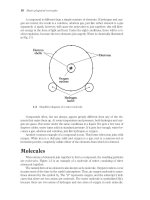Navy Electricity and Electronics Training Series potx
Bạn đang xem bản rút gọn của tài liệu. Xem và tải ngay bản đầy đủ của tài liệu tại đây (1.9 MB, 272 trang )
DISTRIBUTION STATEMENT A: Approved for public release; distribution is unlimited.
NONRESIDENT
TRAINING
COURSE
SEPTEMBER 1998
Navy Electricity and
Electronics Training Series
Module 16—Introduction to Test
Equipment
NAVEDTRA 14188
DISTRIBUTION STATEMENT A: Approved for public release; distribution is unlimited.
Although the words “he,” “him,” and
“his” are used sparingly in this course to
enhance communication, they are not
intended to be gender driven or to affront or
discriminate against anyone.
i
PREFACE
By enrolling in this self-study course, you have demonstrated a desire to improve yourself and the Navy.
Remember, however, this self-study course is only one part of the total Navy training program. Practical
experience, schools, selected reading, and your desire to succeed are also necessary to successfully round
out a fully meaningful training program.
COURSE OVERVIEW: To introduce the student to the subject of Test Equipment who needs such a
background in accomplishing daily work and/or in preparing for further study.
THE COURSE: This self-study course is organized into subject matter areas, each containing learning
objectives to help you determine what you should learn along with text and illustrations to help you
understand the information. The subject matter reflects day-to-day requirements and experiences of
personnel in the rating or skill area. It also reflects guidance provided by Enlisted Community Managers
(ECMs) and other senior personnel, technical references, instructions, etc., and either the occupational or
naval standards, which are listed in the Manual of Navy Enlisted Manpower Personnel Classifications
and Occupational Standards, NAVPERS 18068.
THE QUESTIONS: The questions that appear in this course are designed to help you understand the
material in the text.
VALUE: In completing this course, you will improve your military and professional knowledge.
Importantly, it can also help you study for the Navy-wide advancement in rate examination. If you are
studying and discover a reference in the text to another publication for further information, look it up.
1998 Edition Prepared by
OTMCSRichardHall
Published by
NAVAL EDUCATION AND TRAINING
PROFESSIONAL DEVELOPMENT
AND TECHNOLOGY CENTER
NAVSUP Logistics Tracking Number
0504-LP-026-8410
ii
Sailor’s Creed
“I am a United States Sailor.
I will support and defend the
Constitution of the United States of
America and I will obey the orders
of those appointed over me.
I represent the fighting spirit of the
Navy and those who have gone
before me to defend freedom and
democracy around the world.
I proudly serve my country’s Navy
combat team with honor, courage
and commitment.
I am committed to excellence and
the fair treatment of all.”
iii
TABLE OF CONTENTS
CHAPTER PAGE
1. Test Equipment Administration and Use 1-1
2. Miscellaneous Measurements 2-1
3. Basic Meters 3-1
4. Common Test Equipment 4-1
5. Special-Application Test Equipment 5-1
6. The Oscilloscope and Spectrum Analyzer 6-1
APPENDIX
I. Glossary AI-1
II. References Used to Develop This TRAMAN AII-1
INDEX
INDEX-1
iv
CREDITS
The figures listed below and included in this edition of NEETS, Module 16, Introduction
to Test Equipment, were provided by Huntron Instruments, Inc. Permission to use these
illustrations is gratefully acknowledged. Permission to reproduce these illustrations must be
obtained from the source.
SOURCE
FIGURE
Huntron Instruments, Inc. 5-22, 5-23, 5-24, 5-25, 5-26, 5-27, 5-28
A&B, 5-29, 5-30, 5-31, 5-32, 5-33,
5-34, 5-35, 5-36, 5-37, 5-38
v
NAVY ELECTRICITY AND ELECTRONICS TRAINING
SERIES
The Navy Electricity and Electronics Training Series (NEETS) was developed for use by personnel in
many electrical- and electronic-related Navy ratings. Written by, and with the advice of, senior
technicians in these ratings, this series provides beginners with fundamental electrical and electronic
concepts through self-study. The presentation of this series is not oriented to any specific rating structure,
but is divided into modules containing related information organized into traditional paths of instruction.
The series is designed to give small amounts of information that can be easily digested before advancing
further into the more complex material. For a student just becoming acquainted with electricity or
electronics, it is highly recommended that the modules be studied in their suggested sequence. While
there is a listing of NEETS by module title, the following brief descriptions give a quick overview of how
the individual modules flow together.
Module 1, Introduction to Matter, Energy, and Direct Current, introduces the course with a short history
of electricity and electronics and proceeds into the characteristics of matter, energy, and direct current
(dc). It also describes some of the general safety precautions and first-aid procedures that should be
common knowledge for a person working in the field of electricity. Related safety hints are located
throughout the rest of the series, as well.
Module 2, Introduction to Alternating Current and Transformers, is an introduction to alternating current
(ac) and transformers, including basic ac theory and fundamentals of electromagnetism, inductance,
capacitance, impedance, and transformers.
Module 3, Introduction to Circuit Protection, Control, and Measurement, encompasses circuit breakers,
fuses, and current limiters used in circuit protection, as well as the theory and use of meters as electrical
measuring devices.
Module 4, Introduction to Electrical Conductors, Wiring Techniques, and Schematic Reading, presents
conductor usage, insulation used as wire covering, splicing, termination of wiring, soldering, and reading
electrical wiring diagrams.
Module 5, Introduction to Generators and Motors, is an introduction to generators and motors, and
covers the uses of ac and dc generators and motors in the conversion of electrical and mechanical
energies.
Module 6, Introduction to Electronic Emission, Tubes, and Power Supplies, ties the first five modules
together in an introduction to vacuum tubes and vacuum-tube power supplies.
Module 7, Introduction to Solid-State Devices and Power Supplies, is similar to module 6, but it is in
reference to solid-state devices.
Module 8, Introduction to Amplifiers, covers amplifiers.
Module 9, Introduction to Wave-Generation and Wave-Shaping Circuits, discusses wave generation and
wave-shaping circuits.
Module 10, Introduction to Wave Propagation, Transmission Lines, and Antennas, presents the
characteristics of wave propagation, transmission lines, and antennas.
vi
Module 11, Microwave Principles, explains microwave oscillators, amplifiers, and waveguides.
Module 12, Modulation Principles, discusses the principles of modulation.
Module 13, Introduction to Number Systems and Logic Circuits, presents the fundamental concepts of
number systems, Boolean algebra, and logic circuits, all of which pertain to digital computers.
Module 14, Introduction to Microelectronics, covers microelectronics technology and miniature and
microminiature circuit repair.
Module 15, Principles of Synchros, Servos, and Gyros, provides the basic principles, operations,
functions, and applications of synchro, servo, and gyro mechanisms.
Module 16, Introduction to Test Equipment, is an introduction to some of the more commonly used test
equipments and their applications.
Module 17, Radio-Frequency Communications Principles, presents the fundamentals of a radio-
frequency communications system.
Module 18, Radar Principles, covers the fundamentals of a radar system.
Module 19, The Technician's Handbook, is a handy reference of commonly used general information,
such as electrical and electronic formulas, color coding, and naval supply system data.
Module 20, Master Glossary, is the glossary of terms for the series.
Module 21, Test Methods and Practices, describes basic test methods and practices.
Module 22, Introduction to Digital Computers, is an introduction to digital computers.
Module 23, Magnetic Recording, is an introduction to the use and maintenance of magnetic recorders and
the concepts of recording on magnetic tape and disks.
Module 24, Introduction to Fiber Optics, is an introduction to fiber optics.
Embedded questions are inserted throughout each module, except for modules 19 and 20, which are
reference books. If you have any difficulty in answering any of the questions, restudy the applicable
section.
Although an attempt has been made to use simple language, various technical words and phrases have
necessarily been included. Specific terms are defined in Module 20, Master Glossary.
Considerable emphasis has been placed on illustrations to provide a maximum amount of information. In
some instances, a knowledge of basic algebra may be required.
Assignments are provided for each module, with the exceptions of Module 19, The Technician's
Handbook; and Module 20, Master Glossary. Course descriptions and ordering information are in
NAVEDTRA 12061, Catalog of Nonresident Training Courses.
vii
Throughout the text of this course and while using technical manuals associated with the equipment you
will be working on, you will find the below notations at the end of some paragraphs. The notations are
used to emphasize that safety hazards exist and care must be taken or observed.
WARNING
AN OPERATING PROCEDURE, PRACTICE, OR CONDITION, ETC., WHICH MAY
RESULT IN INJURY OR DEATH IF NOT CAREFULLY OBSERVED OR
FOLLOWED.
CAUTION
AN OPERATING PROCEDURE, PRACTICE, OR CONDITION, ETC., WHICH MAY
RESULT IN DAMAGE TO EQUIPMENT IF NOT CAREFULLY OBSERVED OR
FOLLOWED.
NOTE
An operating procedure, practice, or condition, etc., which is essential to emphasize.
viii
INSTRUCTIONS FOR TAKING THE COURSE
ASSIGNMENTS
The text pages that you are to study are listed at
the beginning of each assignment. Study these
pages carefully before attempting to answer the
questions. Pay close attention to tables and
illustrations and read the learning objectives.
The learning objectives state what you should be
able to do after studying the material. Answering
the questions correctly helps you accomplish the
objectives.
SELECTING YOUR ANSWERS
Read each question carefully, then select the
BEST answer. You may refer freely to the text.
The answers must be the result of your own
work and decisions. You are prohibited from
referring to or copying the answers of others and
from giving answers to anyone else taking the
course.
SUBMITTING YOUR ASSIGNMENTS
To have your assignments graded, you must be
enrolled in the course with the Nonresident
Training Course Administration Branch at the
Naval Education and Training Professional
Development and Technology Center
(NETPDTC). Following enrollment, there are
two ways of having your assignments graded:
(1) use the Internet to submit your assignments
as you complete them, or (2) send all the
assignments at one time by mail to NETPDTC.
Grading on the Internet: Advantages to
Internet grading are:
• you may submit your answers as soon as
you complete an assignment, and
• you get your results faster; usually by the
next working day (approximately 24 hours).
In addition to receiving grade results for each
assignment, you will receive course completion
confirmation once you have completed all the
assignments. To submit your assignment
answers via the Internet, go to:
Grading by Mail: When you submit answer
sheets by mail, send all of your assignments at
one time. Do NOT submit individual answer
sheets for grading. Mail all of your assignments
in an envelope, which you either provide
yourself or obtain from your nearest Educational
Services Officer (ESO). Submit answer sheets
to:
COMMANDING OFFICER
NETPDTC N331
6490 SAUFLEY FIELD ROAD
PENSACOLA FL 32559-5000
Answer Sheets: All courses include one
“scannable” answer sheet for each assignment.
These answer sheets are preprinted with your
SSN, name, assignment number, and course
number. Explanations for completing the answer
sheets are on the answer sheet.
Do not use answer sheet reproductions: Use
only the original answer sheets that we
provide—reproductions will not work with our
scanning equipment and cannot be processed.
Follow the instructions for marking your
answers on the answer sheet. Be sure that blocks
1, 2, and 3 are filled in correctly. This
information is necessary for your course to be
properly processed and for you to receive credit
for your work.
COMPLETION TIME
Courses must be completed within 12 months
from the date of enrollment. This includes time
required to resubmit failed assignments.
ix
PASS/FAIL ASSIGNMENT PROCEDURES
If your overall course score is 3.2 or higher, you
will pass the course and will not be required to
resubmit assignments. Once your assignments
have been graded you will receive course
completion confirmation.
If you receive less than a 3.2 on any assignment
and your overall course score is below 3.2, you
will be given the opportunity to resubmit failed
assignments. You may resubmit failed
assignments only once. Internet students will
receive notification when they have failed an
assignment they may then resubmit failed
assignments on the web site. Internet students
may view and print results for failed
assignments from the web site. Students who
submit by mail will receive a failing result letter
and a new answer sheet for resubmission of each
failed assignment.
COMPLETION CONFIRMATION
After successfully completing this course, you
will receive a letter of completion.
ERRATA
Errata are used to correct minor errors or delete
obsolete information in a course. Errata may
also be used to provide instructions to the
student. If a course has an errata, it will be
included as the first page(s) after the front cover.
Errata for all courses can be accessed and
viewed/downloaded at:
STUDENT FEEDBACK QUESTIONS
We value your suggestions, questions, and
criticisms on our courses. If you would like to
communicate with us regarding this course, we
encourage you, if possible, to use e-mail. If you
write or fax, please use a copy of the Student
Comment form that follows this page.
For subject matter questions:
E-mail:
Phone: Comm: (850) 452-1001, ext. 1728
DSN: 922-1001, ext. 1728
FAX: (850) 452-1370
(Do not fax answer sheets.)
Address: COMMANDING OFFICER
NETPDTC N315
6490 SAUFLEY FIELD ROAD
PENSACOLA FL 32509-5237
For enrollment, shipping, grading, or
completion letter questions
E-mail:
Phone: Toll Free: 877-264-8583
Comm: (850) 452-1511/1181/1859
DSN: 922-1511/1181/1859
FAX: (850) 452-1370
(Do not fax answer sheets.)
Address: COMMANDING OFFICER
NETPDTC N331
6490 SAUFLEY FIELD ROAD
PENSACOLA FL 32559-5000
NAVAL RESERVE RETIREMENT CREDIT
If you are a member of the Naval Reserve, you
will receive retirement points if you are
authorized to receive them under current
directives governing retirement of Naval
Reserve personnel. For Naval Reserve
retirement, this course is evaluated at 5 points.
(Refer to Administrative Procedures for Naval
Reservists on Inactive Duty, BUPERSINST
1001.39, for more information about retirement
points.)
x
THIS PAGE LEFT BLANK INTENTIONALLY.
xi
Student Comments
Course Title:
NEETS Module 16
Introduction to Test Equipment
NAVEDTRA:
14188 Date:
We need some information about you:
Rate/Rank and Name: SSN: Command/Unit
Street Address: City: State/FPO: Zip
Your comments, suggestions, etc.:
Privacy Act Statement: Under authority of Title 5, USC 301, information regarding your military status is
requested in processing your comments and in preparing a reply. This information will not be divulged without
written authorization to anyone other than those within DOD for official use in determining performance.
NETPDTC 1550/41 (Rev 4-00)
1-1
CHAPTER 1
TEST EQUIPMENT ADMINISTRATION AND USE
LEARNING OBJECTIVES
Learning objectives are stated at the beginning of each chapter. These learning objectives serve as a
preview of the information you are expected to learn in the chapter. The comprehensive check questions
included are based on the objectives. By successfully completing the NRTC, you indicate that you have
met the objectives and have learned the information.
Upon completing this chapter, you should be able to:
1. Describe the Ship Configuration and Logistic Support Information System (SCLSIS).
2. State the differences between calibration and repair.
3. Explain the various calibration status labels used by the Navy.
4. List the procedures for obtaining repairs to test equipment.
5. Describe the Metrology Automated System for Uniform Recall and Reporting (MEASURE)
System and the purpose of the Metrology Equipment Recall and Reporting (METER) card and
recall schedule.
6. Describe major test equipment references available to you.
7. Explain the purposes and benefits of testing.
8. State the safety precautions involved in working with test equipment.
9. List three precautions you should observe to avoid damaging electric measuring instruments.
10. State the correct procedures for using a safety shorting probe.
11. Describe resistance, voltage, and current measurements in terms of purposes, methods, and
instruments used.
12. Describe how capacitance and inductance are measured.
13. Explain the operation of bridges in the measurement of unknown resistances, capacitances, and
inductances.
INTRODUCTION
One purpose of this chapter is to acquaint you with the practical use of test equipment. The presence
of adequate test equipment in your shop is not in itself a "cure-all" for making repairs to complex
electronic equipment. You must know how to best use the equipment available. First, however, you must
understand the basis of electronic theory and be able to apply it to the system under repair.
1-2
Another purpose of this chapter is to introduce you to calibration and repair procedures, and basic
voltage and current measurements. You will also learn how ac bridges are used for precise measurements
of resistance, capacitance, and inductance.
Much of the theory of operation and practical applications of the basic types of test instruments used
in electrical and electronic circuits are found in the instruction books and technical manuals that
accompany various equipments. You should read and understand these books before you attempt to use
any test instrument. You should also know the established safety precautions to ensure your safety and
safe equipment operating procedures to protect equipment from damage.
TEST EQUIPMENT IDENTIFICATION
One of the first things you must learn as a maintenance technician is how to identify the various
electronic equipment and components by their appropriate nomenclatures. You will find that several
methods are used to identify test equipment used; this may be somewhat confusing to you at first. For
example, a Tektronix Model 541A oscilloscope can also be identified as a CBTV-541A. The Joint
Electronics Type Designation System (JETDS) is used by all branches of the military to identify
equipment by a system of standardized nomenclatures.
Q-1.
What system is currently used by all branches of the military to identify test equipment?
ELECTRONIC TEST EQUIPMENT CLASSIFICATION
The Electronic Test Equipment Classification Board was established in 1973 to control the increased
use of undesirable electronic test equipment (ETE) in fleet and shore activities. The board classifies
electronic test equipments as GENERAL PURPOSE (GPETE) or SPECIAL PURPOSE (SPETE) and
assigns responsibility for their management. Items classified as general purpose are managed by the
Space and Warfare Systems Command (SPAWARSYSCOM). Items classified as special purpose are
managed by the individual systems command that generates the requirement.
GPETE is test equipment that has the capability, without modification, to generate, modify, or
measure a range of parameters of electronic functions required to test two or more equipments or systems
of basically different design.
Special-purpose electronic test equipment (SPETE) is specifically designed to generate, modify, or
measure a range of parameters of electronic functions of a specific or peculiar nature required to test a
single system or equipment. These special test equipments are procured by the systems command that has
the responsibility for the system/equipment requiring the SPETE for maintenance.
Q-2.
Name the two classes of test equipment.
Q-3.
What test equipment is designed to generate, modify, or measure a range of parameters of
electronic functions of a specific nature required to test a single system or equipment?
Until the ETE classification board was established, the uncontrolled increase in use of nonstandard
GPETE had resulted in loss of inventory control and increased support costs. NESEA has the
responsibility for evaluating requests to purchase nonstandard GPETE and for recommending its approval
or disapproval to NAVSEA. NAVSEA will then forward its final decision to the originating command for
such requests.
1-3
SHIP CONFIGURATION AND LOGISTIC INFORMATION SYSTEM (SCLSIS) PROGRAM
The Navy must maintain, update, and calibrate thousands of pieces of equipment. To do this, the
SHIP CONFIGURATION AND LOGISTIC SUPPORT INFORMATION SYSTEM (SCLSIS) program
was designed to keep track of all installed and portable equipment in the fleet. SCLSIS is used to keep up
with the existence, location, and changes made to equipment. The SCLSIS program seeks to improve the
quality of equipment reporting, provide information needed by other Navy management systems, and
reduce record keeping. It is also designed to assist Navy supply systems that furnish spares,
documentation, and training necessary to support installed and portable equipment.
Therefore, the inventory of assigned test equipment on board ship is directly related to SCLSIS
records. Properly maintained SCLSIS records also show the complete inventory of test equipment on
board by quantity, serial number, and location. The SCLSIS program has two basic elements: (1)
VALIDATION, to establish a baseline data inventory, and (2) INVENTORY UPDATING, to correct
errors or omissions and to document configuration changes.
Q-4.
Name the two basic elements of the SCLSIS program.
CALIBRATION AND REPAIR PROCEDURES
The difference between the terms calibration and repair needs to be addressed before we proceed
further. Calibration is little more than checking, adjusting, or systematically aligning a test instrument to a
known standard. To do this, you must ensure that the equipment you send to the calibration lab is in
working order.
The calibration lab is where actual repair work becomes important. Obvious problems, such as open
power cords, burned components, broken meters, and missing hardware, should be repaired or replaced
before sending equipment to the calibration lab. Most calibration labs with which you will deal will be
part of an intermediate maintenance activity (IMA) on board a tender.
CALIBRATION STATUS
You can determine the calibration status of any test equipment by checking the calibration label or
tag located on the equipment. These calibration labels or tags advise you as to whether the item is usable
and within its calibration interval. Tags and labels to be used in the METROLOGY CALIBRATION
(METCAL) coordination program are listed in the following paragraphs. No other calibration labels or
tags are authorized to be placed on test equipment.
Calibrated Label
The CALIBRATED label, shown in view A of figure 1-1, has black lettering and a white
background and comes in two sizes. It is the most commonly used label in the METCAL program. This
label indicates that the instrument to which it is attached is within its applicable tolerance on all
parameters. If there are any qualifying conditions for use of the instrument, one of the other labels
described in the next paragraphs should be used.
1-4
Figure 1-1.—Calibration labels and tags.
Calibrated—Refer to Report Label
The CALIBRATED—REFER TO REPORT label, shown in view B of figure 1-1, has red lettering
and a white back ground. It comes in two sizes and is used when you must know the actual measurement
values to use the instrument.
1-5
Q-5.
What calibration label is used when actual measurement values must be known to use the test
equipment?
Special Calibration Labels
Two SPECIAL CALIBRATION labels are shown in view C of figure 1-1 that have black lettering
and a yellow background; the size and content of the labels are different. A SPECIAL CALIBRATION
tag (figure 1-1, view C) is used with the smaller of the two labels. These labels or tag are used when some
unusual or special condition in the calibration should be drawn to your attention.
Such special conditions may be deviations from usual calibration tolerances, multiple calibration
intervals, or a requirement for in-place calibration. The special condition that resulted in the SPECIAL
CALIBRATION label should be described on the large label when sufficient space is available on the
instrument or on the tag when the small label is used. Brief descriptions of special conditions are provided
in the following paragraphs.
Q-6.
An instrument that must be calibrated in place requires what type of calibration label?
In cases where you do not require full instrument capability, the calibration can be performed with
reduced tolerances or cover less than all ranges and parameters. This approach is often used when the
instrument does not meet full calibration tolerances on certain ranges or parameters, but can still meet
user requirements. On the other hand, the special calibration may be for higher accuracy than usual on a
short-term basis upon your specific request.
MULTIPLE CALIBRATION INTERVALS.—Some instruments have components that require
calibration less frequently than the rest of the instrument. For example, the attenuator in a signal generator
may require calibration every 12 months, whereas the rest of the instrument parameters should be
calibrated every 4 months. Since the attenuator calibration is time consuming and may require unavailable
standards, use of the multiple-interval approach can save considerable time (man-hours) as well as permit
the more frequent calibration to be performed at a lower level laboratory.
When a specific instrument has been designed for multiple calibration intervals, such information is
provided in the applicable calibration procedure. The SPECIAL CALIBRATION label or tag is annotated
with the words MULTIPLE INTERVAL, and the type of calibration performed is indicated; for example,
partial 1 of 2, 2 of 2, complete calibration, and so forth. The calibration due date reflects the due date of
the next partial or complete calibration.
CALIBRATION IN-PLACE.—Some instruments should be calibrated in-place. Annotation on the
SPECIAL CALIBRATION label or tag will alert both you and the calibrator that the instrument should
not be removed, but should be calibrated in-place.
User Calibration Label
Some test and measuring equipment (T&ME) should be calibrated by you instead of your referring
the instrument to a calibration facility. For example, some instruments, such as hardness testers and
densitometers, are provided with their own standards and should be calibrated each time used, or at least
very frequently. Some instruments, such as oscillographic recorders, may require calibration before,
during, and after each use.
Other automatic test equipment (ATE) have self-calibration tests that should be performed each time
used or each day of use. Still other instruments are calibrated as part of checkout procedures performed
daily or weekly and recorded in maintenance logs. Whenever recognized, the requirement for calibration
1-6
by the user and the calibration interval (each use—daily, weekly, every 100 hours—each overhaul, and so
forth) is indicated in the Metrology Requirements List (METRL).
The USER CALIBRATION label, shown in view D of figure 1-1, has black lettering and a white
background and is affixed when the calibration is performed by the user; however, this label is not
replaced at each calibration. When the label is first attached to the instrument, it is annotated as to the
appropriate calibration interval. Records of calibrations performed, when other than each time used,
should be by normal maintenance practices; that is, in the maintenance log, on maintenance action forms,
and so forth.
Inactive—Calibrate Before Use Label
In the event that an individual instrument due for recalibration will not be used for some time in the
future, you may indefinitely postpone the recalibration by affixing an inactive label to the instrument. As
shown in view E of figure 1-1, the INACTIVE—CALIBRATE BEFORE USE label has green lettering
and a white background. The INACTIVE label remains on the instrument until it is recalibrated. The
instrument is not to be used while bearing this label.
Calibration Not Required Label
Test equipment standards and T&ME not requiring calibration are shown as CALIBRATION NOT
REQUIRED. This label, shown in view F of figure 1-1, has orange letters and a white background. It is
attached to and should remain on the instrument indefinitely unless its calibration requirements change. If
the instrument is not listed in METRL, you should use the following criteria when placing instruments in
the CALIBRATION NOT REQUIRED category:
• Instrument does not make quantitative measurements nor provide quantified outputs.
• The device is "fail-safe"; that is, operation beyond specified tolerances will be apparent to the
user.
• All measurement/stimulus circuits are monitored during use by calibrated instruments or are
dependent on external known or calibrated sources for performance within required limits. (When
determining that an instrument falls into the CALIBRATION NOT REQUIRED category, you
should annotate the label as to the authority for the decision, such as METRL, technical manual,
letter or message from higher authority.)
Rejected—refer To Attached Tag Label
In the event that an instrument fails to meet the acceptance criteria during calibration and cannot be
adequately repaired, a REJECTED—REFER TO ATTACHED TAG label is placed on the instrument and
all other servicing labels removed. This label, as shown in view G of figure 1-1, has black letters and a
red background. In addition to the REJECTED label, a REJECTED tag, giving the reason for rejection
and other information as required, is attached to the instrument. Both the label and tag remain on the
instrument until it is repaired and recalibrated. The instrument is not to be used while bearing a
REJECTED label.
Calibration Void If Seal Broken Label
The CALIBRATION VOID IF SEAL BROKEN label, shown in view H of figure 1-1, has black
letters and a white background. It is placed over readily accessible (usually exterior) adjustments to
prevent tampering by the user when such tampering could affect the calibration. The label should not be
1-7
used to cover adjustments or controls that are part of the normal use and operation of the instrument. This
label may also be used to prevent removal and/or interchange of plug-ins, modules, subassemblies, and so
forth, when such removal or interchange would affect the calibration.
REPAIR PROCEDURES
If you are unable to replace a known failed component with onboard spares, you can often locate the
replacement component from other supply sources. The replacement component can then be delivered,
along with the inoperative equipment, to the IMA. So by sending the repair part along with the
equipment, you can reduce repair time considerably. This is particularly true when your unit is getting
under way and no time is available for you to complete the repair before calibration. Most operational
commands have a higher supply priority for purchase of repair parts than the IMA can use.
"No Reject" Policy
IMAs have a "no reject" policy on test equipment to provide operational test equipment in a more
timely manner. The "no reject" policy says, in effect, that test equipment submitted to the IMA for
calibration, which is later found to require repair, will be repaired by the repair department of the IMA.
Before this policy, any equipment found inoperative by the calibration lab was marked REJECTED, the
reasons stated, and the equipment returned uncalibrated to the ship for repairs. The "no reject" policy does
not relieve you of your responsibility to ensure your equipment is in working order prior to submitting it
for calibration. Its purpose is to streamline the procedure and cut down delays in returning your
equipment to you calibrated and ready to use.
Responsibility for Repair and Maintenance of Test Equipment
Generally, the responsibility for repair and maintenance of test equipment is placed on maintenance
personnel. In some cases, however, maintenance personnel are not authorized to make repairs. Then the
test instrument must be sent to a shore repair/calibration facility.
Q-7.
Responsibility for repair and maintenance of test equipment generally rests with what group of
personnel?
When test equipment is sent for calibration and repair, all accessories, such as probes, adapters, and
calibration sheets, should be included. Only in emergencies or special situations should partial repair or
calibration be attempted on test equipment designated as nonrepairable. Such emergency repairs should
be noted on a tag attached to the unit and an entry made on the MEASURE card (discussed shortly). The
equipment should then be sent at the earliest opportunity to an authorized facility so that permanent
repairs can be made and the unit calibrated.
STOWAGE AND HANDLING OF TEST EQUIPMENT
Most electronic test equipment is precision equipment. Such equipment must be handled with care to
properly perform its designed functions. Rough handling, excessive heat, moisture, and dust all affect the
useful life of the equipment. Bumping or dropping a test instrument may ruin the calibration of a meter,
cause short circuits, or damage electronic elements inside the case. Sharp bends, creases, or dents in
coaxial test cables can alter the expected attenuating effect and cause false meter readings or
measurements. Forced air cooling, dust filters, and heaters are used in many pieces of equipment. This
test equipment requires clean air filters for proper ventilation and a warm-up period that permits units in
the equipment to maintain calibrated standards.
Electronic test equipment should be stowed in a dry location with the dust cover (if provided) in
place. Dust covers for spare plug-in units should be constructed for such stowage. For ease in performing
1-8
maintenance, the test equipment should be stowed at a location convenient to equipment spaces. If
possible, related test equipment should be mounted in the equipment spaces. This reduces the problem of
finding adequate stowage space elsewhere.
In stowage spaces, individual pieces of test equipment should be held in place by stretch seat-belt-
type straps. If bars are used to hold equipment on shelves, meters and control knobs should be protected
by blocking the equipment to prevent it from rolling and sliding on the shelf. Test equipment too large for
shelf stowage should be kept in stowage cases and tie-downs provided to secure the cases. Refer to
Stowage Guide for Portable Test Equipment, NAVSEA ST000-AB-GYD-010/GPETE, to determine
adequate stowage space and proper weight support requirements.
THE METROLOGY AUTOMATED SYSTEM FOR UNIFORM RECALL AND REPORTING
(MEASURE)
For the sake of simplicity, we will use the more commonly used acronym MEASURE instead of the
full name to describe this system in the next discussion.
MEASURE is a data processing system designed to provide a standardized system for the recall and
scheduling of test, measurement, and diagnostic equipment (TMDE) into calibration facilities. It also
provides for the documentation of data pertaining to the calibration actions performed by these facilities.
The primary reference document that describes the operation of the MEASURE system is Metrology
Automated System for Uniform Recall and Reporting (MEASURE) Users Manual, OP 43P6A. The Chief
of Naval Operations oversees this program and establishes policy and guidelines.
Q-8.
What Navy office oversees the MEASURE program?
Each naval activity must ensure that the test equipment for which it has been assigned primary
responsibility is submitted on a timely basis to a calibration activity for required calibration.
The MEASURE program is designed to assist these naval activities in the fulfillment of this
responsibility. MEASURE does this by providing for the automatic scheduling and recall of all such test
equipment for calibration.
Each activity submits an initial inventory, using the form shown in figure 1-2, to its Metrology
Calibration Representative (METCALREP) for approval. The METCALREP then forwards the inventory
to the Measure Operational Control Center (MOCC). The MOCC, based on the information contained on
these inventory report forms, provides the necessary preprinted Metrology Equipment Recall and
Reporting (METER) card. Figure 1-3 illustrates a MEASURE METER card.
1-9
Figure 1-2.—MEASURE TMDF Inventory report form.
1-10
Figure 1-3.—MEASURE METER card.
In part, the METER card is preprinted with information taken from the initial inventory data
submitted on the inventory report forms together with such updated data as may appear on any prior
METER card. The remaining information required is entered on the card by the user of the equipment or
the calibration activity, as appropriate.
1-11
The METER card is used to report changes, additions, or deletions to the user activity’s inventory. It
is also used to report changes in custody of the item of test equipment. The procedure for filling out the
METER card is outlined in the appendixes of the MEASURE Users Manual. Blank METER cards can be
obtained through the responsible METCALREP.
A computer printout recall schedule is also generated by the MEASURE system. The purpose of this
printout is to list those items of equipment that are due for calibration. Each recall schedule is composed
of a set of four identical copies. One set is provided to the calibration activity as an aid to workload
planning; a second set is sent to the user’s activity. The recall schedule is one of several products/formats
sent automatically by the MEASURE Operation Control Center to the user activity on a regular basis. The
MOCC automatically distributes the following products to user activities at the intervals shown:
DOCUMENT TITLE TYPE DOCUMENT INTERVAL
Format 215 Unmatched listing As required
Format 310 Test equipment inventory Monthly
Format 350 Test equipment inventory in sub-custodian order Monthly
Format 804 Recall schedule for on-site equipment Monthly/Quarterly
Replenishment cards Preprinted METER card As required
Blank METER cards Initial issue
TEST EQUIPMENT REFERENCES
Several publications that contain information concerning test equipment are required to be
maintained aboard ship by type commander instructions. These requirements are usually found in the
inspection checkoff list. Other publications, while not required by directive, are necessary to you as
reference and study material so you will be able to administer an effective test equipment program.
Technicians should become familiar with the publications/directives listed in appendix II of this module.
INTRODUCTION TO TROUBLESHOOTING
Our military forces increasingly rely on electrical and electronic equipment to help perform their
mission. The effectiveness of our tactical forces depends on many types of electronic systems, such as
communications systems, detection systems, and fire control systems. The reliability of such equipment is
determined by many factors; however, the primary factors are the quality of the equipment in use, the
availability of spare parts, and the ability of maintenance personnel to perform adequate maintenance.
Maintenance is work done to correct, reduce, or counteract wear, failure, and damage to equipment.
Maintenance of electrical and electronic equipment is divided into two main categories: PREVENTIVE
(routine) and CORRECTIVE maintenance. Preventive maintenance consists of mechanical, electrical, and
electronic checks to determine whether equipment is operating properly. It also consists of visual
inspections of cabling and equipment for damage and to determine if lubrication is needed. Corrective
maintenance isolates equipment failure by means of test techniques and practices; it also replaces
defective parts and realigns or readjusts equipment to bring it back to proper performance.
Q-9.
What are the two main categories of maintenance?
Q-10.
What type of maintenance involves isolating equipment troubles and replacing defective parts?









